How To Fix Loose Carpet On Stairs
Carpet Maintenance Tips: 3 Quick Carpet Fixes
Get pro results—without the pro price
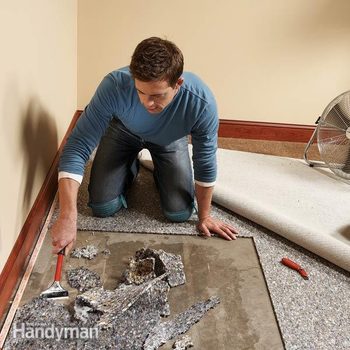 Family Handyman
Family Handyman
Save a bundle by fixing common carpet and rug problems like burn spots, loose wall-to-wall carpet, and wet carpet using basic tools and know-how. This article walks you through the steps.
You might also like: TBD
Overview
The carpet in your home is a big investment. So it's frustrating when a sputtering ember burns a hole in your beautiful rug or a spring storm floods the basement family room. But you don't have to call in a pro or just live with the damage until you replace the carpet. Solving these problems yourself isn't difficult, and you can increase the life of your carpet and save some real money.
We'll show you how to fix three common problems:
- Small damaged spots such as holes, tears or burns.
- Wet carpet from leaks or flooding.
- Carpet that has pulled out of a metal threshold.
A carpet pro may charge hundreds for each of these repairs. If the repair involves a large area or the damage is more extensive, the cost can double. Doing the work yourself can cut the cost by two-thirds. The tools and materials you'll need are at home centers; most cost $15 or less.
Patch a damaged spot
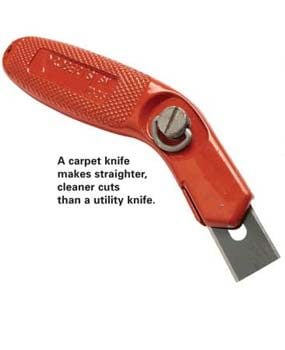
Carpet knife
A carpet knife makes straighter, cleaner cuts than a utility knife.
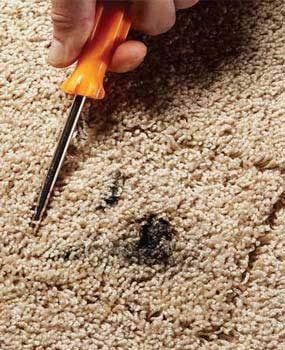
How to Fix Burned Carpet Photo 1: Mark the cut
Part the carpet fibers with a Phillips screwdriver. The parts mark your cutting lines and let you cut the backing without cutting or tearing the fibers.
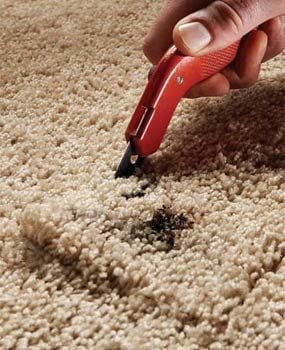
How to Fix Burned Carpet Photo 2: Cut the carpet
Cut through the carpet backing. Make the cuts as straight as you can and avoid cutting completely through the carpet pad.
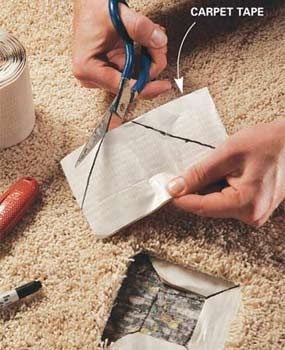
How to Fix Burned Carpet Photo 3: Test-fit the piece
Test-fit all the pieces of carpet tape before you stick them in place permanently. Mark a square on the carpet pad to help align each piece later.
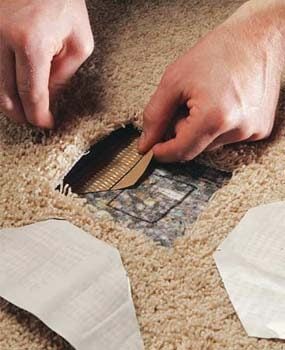
How to Fix Burned Carpet Photo 4: Peel the tape backing
Peel off the tape's backing and set each piece in place, sticky side up. Don't let the super-sticky tape touch the carpet backing—or anything else—until it's in position.
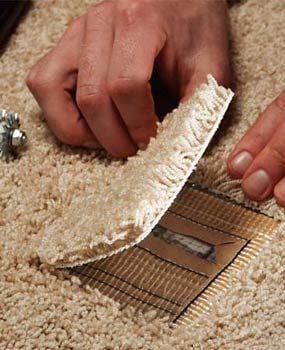
How to Fix Burned Carpet Photo 5: Place the plug
Set the plug tightly against one side of the hole. Then lower the other edges into place, holding back the surrounding fibers. Press the plug into the tape with your fingers, then with a carpet tractor.
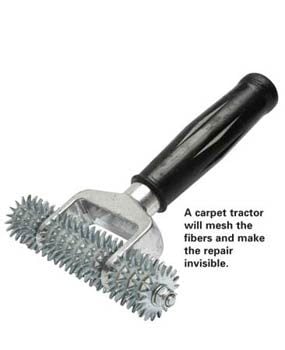
Carpet tractor
A carpet tractor will mesh the fibers and make the repair invisible.
You can patch a small hole, tear or burn using techniques that will make the repair virtually invisible. You'll need a small "plug" of carpet that matches the damaged piece. If you don't have a remnant, you can steal a piece from inside a closet or underneath a piece of furniture you never intend to move. (This may sound extreme, but it's a lot cheaper than replacing the entire carpet.)
If you have a "plush"-type carpet with a flat surface and no pattern, you can make a repair that's absolutely invisible. If your carpet has a color pattern, a textured surface design or looped yarn, you'll have to be fussier when you cut the plug, and the repair may be visible (but you're probably the only one who will notice it).
Before starting this repair, buy a carpet knife that has replaceable blades. You'll also need a roll of one-sided carpet tape. Be sure to choose heavy-duty tape reinforced with mesh, not the thin, flimsy version or the "hot-melt" type that requires a special iron to apply.
Carpet Burn Repair: Cut out the damage and a matching plug
Be sure the area you're working in is well lit. To mark the area you'll cut out, part the carpet fibers around the damage as if you were parting your hair (Photo 1). Keep the part lines at least 1/2 in. from the damaged spot. Cut along the parts using a sharp, new blade in your carpet knife (Photo 2).
Next, cut a replacement plug, using the cutout as a template. To start, make a first cut in the replacement material, using a straightedge to guide your carpet knife. Then set the cutout on the replacement material with one edge aligned along that first cut. When you lay the cutout on top of the replacement material, make sure their naps are running in the same direction. You can tell which direction the nap is running by rubbing your hand over the carpeting and watching which way the fibers fall or stand up. Once you have the cutout lined up correctly, part the fibers around the three uncut sides just as you did before.
Cut along the parts and test-fit the plug in the cutout hole, making sure the nap of the plug matches the nap of the surrounding carpet. If the plug is a little too big, trim off a single row of fibers with sharp scissors (old, dull scissors will tear the fibers).
Carpet Burn Repair: Prepare the hole for the new plug
Cut pieces of carpet tape and position them in the hole without removing the backing (Photo 3). Cut the ends of the tape diagonally so the pieces will frame the hole without overlapping. The tricky part is getting the tape positioned so it's halfway under the plug and halfway under the surrounding carpet. A helper makes this easier.
After marking their positions in the hole, remove the pieces from the hole and carefully (this is sticky stuff!) remove the protective backing from the tape. While pulling the carpeting up with one hand, slip the tape pieces back into the prepared hole one piece at a time (Photo 4). Be sure the edges of the tape line up with your markings.
Carpet Burn Repair: Insert the plug
Now you're ready to fit the new plug into the hole. Pull the fibers of the surrounding carpet back from the edges. Push one side of the plug lightly onto the tape to make sure it's set exactly right—you really only have one shot at this (Photo 5). After you're sure the plug is placed correctly, use your fingers to work in the direction of the nap all the way around the hole as you press the plug down firmly onto each side of the tape.
A carpet tractor will do the best job of meshing the fibers, but a seam roller or even a rolling pin would work too. Place a telephone book on top of the plug overnight. Trim any fibers sticking up with a sharp scissors. You'll be surprised how "invisible" this repair is once you're finished. You can vacuum and clean your carpeting as you normally would, and this repair should last as long as your carpet does.
Rescue wet carpet
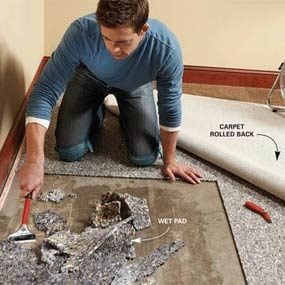
Photo 1: Dry the carpet
Dry out wet carpet right away. Fold back the carpet and start a fan. Cut around the soaked section of the pad and scrape it up.
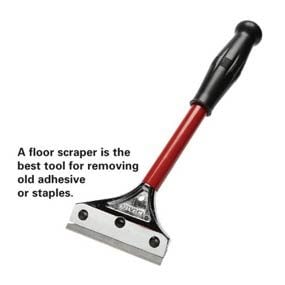
Floor scraper
A floor scraper is the best tool for removing old adhesive or staples.

Photo 2: Lay replacement pad
Lay replacement pad after the floor has dried. Duct-tape the seams where new pad meets old, and fasten the pad to the floor with adhesive or staples.
When carpet gets soaked, you have to act fast. The longer it stays soggy, the more likely it is to stretch out, discolor or get moldy. If a large area is waterlogged, complete replacement may be the best option. But if only a corner or a small room is soaked, you can save the carpet with just a couple of hours of work.
Tear out the soggy pad
First, go to the corner nearest the wet area, grab the carpet with pliers and pull the carpet off the tack strip. Continue pulling the carpet off the tack strip by hand until you can fold back the entire wet section. Run a fan or two to dry the carpet.
Wet carpet pad is like a big sponge. You have to get rid of it ASAP. Cut around the wet area with a utility knife. Make straight cuts so you have straight seams when you patch in the new pad. If the pad is glued to a concrete floor, scrape it up with a floor scraper (Photo 1). If the pad is stapled to a wood subfloor, just pull up chunks of pad and pry or pull out the staples if you have just a few. For faster removal on a larger area, use a floor scraper. Have garbage bags handy to prevent drips on the carpeting. Wet pad is heavy. Don't fill the bags so full that you can't haul them out without wrecking your back!
Wipe up any water on the floor, then flop the wet carpet back into place. Drying it flat and in place helps the carpet retain its shape. Run fans until the floor and carpet are completely dry. This can take a couple of days.
Patch in the new pad
Measure the area of pad you need to replace and take a piece of the old pad to a flooring store or home center to find similar replacement pad. The color doesn't matter, but the new pad must be the same thickness and density as the old pad. Some stores will cut the pad to the size you need.
Fasten the pad to a concrete floor with carpet pad adhesive and duct-tape the seams together (Photo 2). On a wood subfloor, all you need is a staple gun and 5/16-in. staples. Use a utility knife to trim off any pad covering the tack strip.
Reattach the carpet
As you refasten the carpet to the tack strip, you need to stretch it toward the wall. If you're dealing with a corner or a small area, you can use a knee kicker alone (see Photo 3). Starting at one end of the loose carpet, set the head of the kicker about 2 in. from the tack strip and nudge the carpet tight against the wall. Force the carpet into the tack strip with a stiff putty knife. Also tuck the edge of the carpet into the space between the wall and the tack strip with a putty knife. Continue along the wall, moving the kicker over about a few inches each time.
If you're dealing with a larger area of carpet or if the carpet has stretched out of shape, bubbled or wrinkled after getting wet, you'll need to rent a power stretcher to restretch the carpet.
Reattach pulled-out carpet
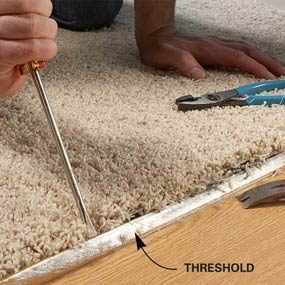
Photo 1: Release the carpet
Bend open the threshold's lip to release the carpet. Be careful not to snag the carpet as you push the screwdriver under the lip.
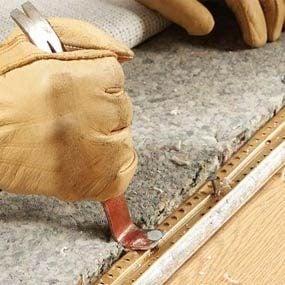
Photo 2: Pull the nails
Pry up the threshold just enough to raise the nail heads. Then pull the nails and remove the threshold. Work from the carpeted side to avoid scratching the hard flooring. Nail down a new threshold.
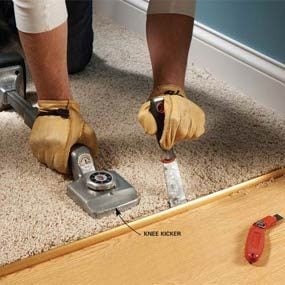
Photo 3: Kick the carpet tight
Nudge the carpet toward the threshold with a rented "knee kicker" and force the carpet into the threshold's teeth with a stiff putty knife.
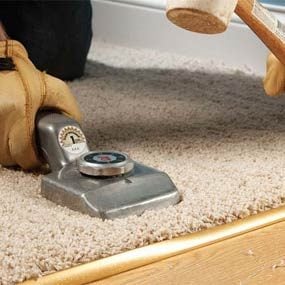
Photo 4: Lock the carpet down
Drive down the lip, tapping gradually back and forth along its entire length. On the final pass, pound hard to lock the carpet into the threshold.

Knee kicker
You can rent a knee kicker at rental centers or carpet stores.
If you have carpet that has pulled loose from a metal threshold, fix it now, before the exposed edge of the carpet begins to fray. If the damage extends more than an inch or so away from the threshold, you won't be able to make a good-looking repair. Aside from standard hand tools, you'll need a carpet knife and a knee kicker, which you can get at any rental center. You'll also need a new metal threshold and 1-1/2-in. ring-shank drywall nails.
Remove the old threshold
This repair is much easier if you first remove the door. You can do it with the door in place, but it'll take a little longer and you risk scratching the door. Carefully pry up the lip of the existing metal threshold along its entire length using a screwdriver or flat pry bar (Photo 1). Since you'll be replacing the threshold, you don't have to worry about wrecking it, but you want to work carefully so you don't damage the carpet edge even more. Once the threshold lip is bent up, use pliers to gently pull the carpeting up from the teeth inside the threshold. Roll the carpet back slightly to get it out of the way (you can leave the carpet pad in place).
Pry up the threshold slightly and pull the nails (Photo 2). To get an exact measurement for cutting the new threshold, don't measure the old threshold because it may be kinked. Instead, measure the opening and then cut the threshold with metal snips or a hacksaw.
Install the new threshold
If the carpet edge is in good shape, you can place the new threshold exactly where the old one was. If the edge is badly frayed, you'll need to trim off the damage using a carpet knife and a straightedge. Then position the new threshold farther into the carpeted room to compensate for the width you trimmed off. In most cases, you can place the new threshold about 1 in. from the original position, but not more. If you've moved the threshold more than an inch, you may also need to trim the carpet pad so it doesn't cover the threshold pins.
If you're working on a wood sub- floor, nail down the replacement threshold with 1-1/2-in. ring-shank drywall nails. On a concrete floor, use heavy-duty construction adhesive to glue the threshold to the floor, and allow a day for it to dry before moving on to the next step.
Attach the carpet
Now you're ready to attach the carpet to the new threshold. Starting at one end of the threshold, set the head of the knee kicker about 2 in. from the threshold and kick with your knee to stretch the carpet toward the thresh- old (Photo 3). Kick firmly, but not with all your strength or you might rip the carpet. Force the carpet into the threshold teeth with a stiff putty knife. Then move the kicker over a few inches (the width of the kicker's head) and repeat the process until you reach the other end of the threshold. When you're done, tuck any loose carpet under nearby baseboards with a stiff putty knife. Finally, pound down the threshold lip with a rubber mallet (Photo 4).
Required Tools for this Project
Have the necessary tools for this DIY project lined up before you start—you'll save time and frustration.
You'll also need a carpet knife, scissors, a carpet tractor, a floor scraper, a fan, a knee kicker and leather gloves.
Required Materials for this Project
Avoid last-minute shopping trips by having all your materials ready ahead of time. Here's a list.
Similar Projects
How To Fix Loose Carpet On Stairs
Source: https://www.familyhandyman.com/project/carpet-maintenance-tips-3-quick-carpet-fixes/
Posted by: yoderhadegre.blogspot.com

0 Response to "How To Fix Loose Carpet On Stairs"
Post a Comment